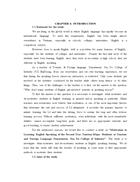




Mã tài liệu: 301825
Số trang: 41
Định dạng: rar
Dung lượng file: 378 Kb
Chuyên mục: Sư phạm
[FONT=Times New Roman]Introduction
1.1 Rationale for the study
We are living in the global world in which English language has rapidly become an international language. To meet this requirement, English has been taught almost everywhere in Vietnam, especially in schools, colleges, universities, English is a compulsory subject.
However, how to speak English well is a problem for many learners of English, especially for the students of colleges and universities. Despite the fact that most of the students have been learning English since they were at secondary or high school, they are deficient in English speaking.
As a teacher of Tourism & Foreign language Department, Sao Do College of Industry SCI, HaiDuong, from our observation and our own teaching experience, we see that during the speaking lesson classroom interaction is restricted. Only some students get involved in the activities conducted by the teacher while others keep silence or do other things. Thus, one of the challenges to the teacher is to find out the answer to the question “Why don’t many students of English get involved actively in speaking lesson?”
To find the answer to this question it is necessary to investigate what motivates and de-motivates students in English learning in general and in speaking in particular. Many teachers and researchers now believe that motivation is one of the most important factors that determine the rate and success of L2 attainment: it provides the primary impetus to initiate learning the L2 and later the driving force to sustain the long and often tedious learning process. Without sufficient motivation, even individuals with the most remarkable abilities cannot accomplish long-term goals, and there are no appropriate curricula and good teaching to ensure student achievement.
For the mentioned reasons, we would like to conduct a study on “Motivation in Learning English Speaking of the Second Year Tourism-Major Students at Tourism and Foreign Language Department, Sao Do College of Industry”. The study is to investigate what motivates and de-motivates students in English speaking learning. We do hope that this study will help the teacher of speaking in some ways to find appropriate methods to motivate their students.
1.2 Aims of the study
The study aims at investigating the motivation in English speaking learning among the second year tourism-major students at Tourism and Foreign Language Faculty, Sao Do Industrial College. The four main purposes of the study are summarized below:
1. To examine kinds of motivation possessed by the second year tourism major students at Tourism and Foreign Department, Sao Do College of Industry.
2. To examine methods and techniques used by teachers of speaking to motivate their learners in speaking activities.
3. To investigate factors de-motivating students in English speaking learning?
4. To suggest motivational strategies and techniques, which can be applied to stimulate learners in teaching speaking skill.
1.3 Scope and significance of the study:
There are many factors affecting the success or failure of learning a foreign language, in which motivation is one of the key factors. The focus of this study is on motivation as a separate factor in English speaking learning. The results of the study will be applied to improve the speaking skills of second tourism major students of Tourism & Foreign Language Department, SCI. It can not be said that the results are general to all students in Vietnam.
1.4 Design of the study
The study is designed with 3 chapters.
Chapter one presents the rationale for study, aims of the study, research questions as well as the scope of the study.
Chapter two displays the background of motivation and speaking teaching. In the chapter, the main approaches to motivation and de-motivation in foreign language teaching are discussed. The main theories of foreign language speaking teaching are also presented in the chapter.
Chapter three presents the methodology performed in the study. The chapter also deals with documentation, data analysis. The analysis and discussion on the data is based on the survey questionnaire, interview and classroom observation.
Chapter four summarizes the findings, implication, recommendations and future directions for future research are also provided in the last chapter.
Những tài liệu gần giống với tài liệu bạn đang xem
📎 Số trang: 6
👁 Lượt xem: 432
⬇ Lượt tải: 18
📎 Số trang: 56
👁 Lượt xem: 507
⬇ Lượt tải: 16
📎 Số trang: 74
👁 Lượt xem: 456
⬇ Lượt tải: 16
📎 Số trang: 42
👁 Lượt xem: 738
⬇ Lượt tải: 16
📎 Số trang: 46
👁 Lượt xem: 566
⬇ Lượt tải: 23
📎 Số trang: 1
👁 Lượt xem: 397
⬇ Lượt tải: 16
📎 Số trang: 39
👁 Lượt xem: 633
⬇ Lượt tải: 16
📎 Số trang: 57
👁 Lượt xem: 372
⬇ Lượt tải: 16
📎 Số trang: 58
👁 Lượt xem: 872
⬇ Lượt tải: 19
📎 Số trang: 6
👁 Lượt xem: 610
⬇ Lượt tải: 17
Những tài liệu bạn đã xem
📎 Số trang: 41
👁 Lượt xem: 566
⬇ Lượt tải: 16
 Motivation in learning english speaking of the second year tourism major students at tourism and foreign language department sao do college of indust
[FONT=Times New Roman] Introduction 1.1 Rationale for the study We are living in the global world in which English language has rapidly become an international language. To meet this requirement, English has been taught almost everywhere in
zip Đăng bởi
petrogas11
Motivation in learning english speaking of the second year tourism major students at tourism and foreign language department sao do college of indust
[FONT=Times New Roman] Introduction 1.1 Rationale for the study We are living in the global world in which English language has rapidly become an international language. To meet this requirement, English has been taught almost everywhere in
zip Đăng bởi
petrogas11